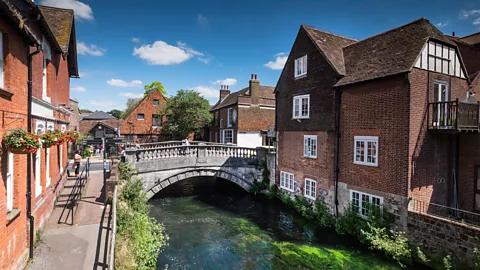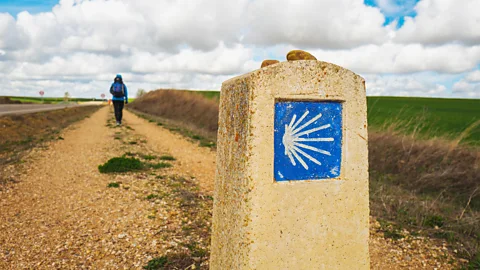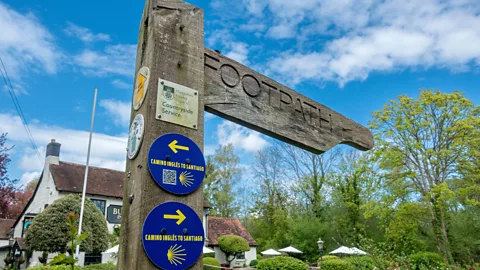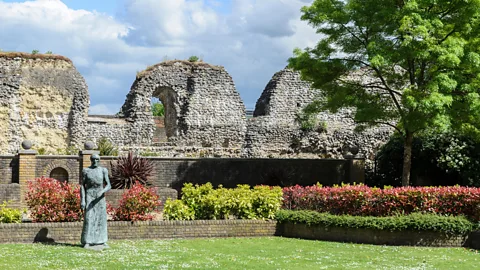St James Way: The return of the UK's medieval highway
 Britpix/Alamy
Britpix/AlamyThe growing popularity of the Camino de Santiago has spurred the revival of a newly marked 68.5-mile pilgrimage in south-east England.
I was balancing on one leg, arms outstretched like a scarecrow. I turned my head in slow motion to look for my shoe over my right shoulder, which made my standing leg and arms flail like an inflatable tube man. I retreated back to my one-legged scarecrow, unsure of what to do next.
It was a stormy afternoon and I was stuck in a cabbage field in rural Berkshire. Walking through flooded English farmland during one of the wettest Marches on record, I'd slipped out of my left boot, leaving me balancing on one foot over a muddy puddle that was big enough to bathe in. In the sky, two red kites circled above me, letting out high-pitched whistles between swoops. At first, I thought they were laughing at my failed attempts to escape the mud, but it soon dawned on me that I looked like a drowned field mouse, and they were likely eyeing me for dinner.
With rain seeping through my jacket and my hiking boot lost to a cabbage field, I wanted to give up. But then I saw something ahead that urged me to continue: a yellow scallop shell on a blue roundel.
 RooM the Agency/Alamy
RooM the Agency/AlamyI was a just child when I saw my first Camino sign. Between the ages of three and 10, I lived in what was then a small dirt-road village on the south-east coast of Spain. The elongated scallop shell at the end of my road pointed north to Galicia, leading pilgrims across the Iberian peninsula to Santiago de Compostela, where the remains of St James the Apostle are said to be buried in the city's 10th-Century cathedral.
A network of medieval routes across Spain, and Portugal, the Camino de Santiago grew in popularity after the Galician priest Father Elías Valiña Sampedro marked the route with yellow arrows in the 1980s. But it wasn't until 2019 – when a record-breaking 347,585 people hiked the Camino – that pilgrim numbers approached those of the medieval period, when 500,000 people walked the Camino every year. After two years of pandemic restrictions, 2023 is expected to be the Camino's busiest year yet.
The Camino's growing popularity has encouraged the revival of pilgrimage routes across Europe in recent years, the latest of which is in south-east England. I was walking the newly waymarked St James Way, a 68.5-mile trail from Reading – the seat of St James in medieval England – to Southampton, where medieval English pilgrims would have set sail for Spain to begin the so-called Camino Ingles from Ferrol or A Coruña to Santiago de Compostela. While this path sees far fewer pilgrims than the Camino's more-popular Camino s and Camino Portugues routes, new signposting, OS mapping and a network of pubs and churches offering stamps aim to revive England's lost pilgrimage culture.
I eventually dragged the boot towards me with the help of a sodden stick. Back on two legs, I soon reached the scallop shell – one of 432 new waymarkers put up by volunteers to help navigate pilgrims – and continued on my way.
 Gregory Davies/Alamy
Gregory Davies/Alamy"Unless you see yellow arrows and scallop shells, it isn't a Camino," said David Sinclair, a Confraternity of St James (CSJ) volunteer who led the trail's waymarking project. Sinclair ed the CSJ in 2012 after walking the Camino s from Saint-Jean-Pied-de-Port to Santiago de Compostela. "CSJ had already done a lot of research on the route when I ed, but I felt that for the St James Way to be recognised as a Camino, we needed to waymark it. We also needed stamps."
Sinclair's waymarking project came after Galician authorities reduced the minimum kilometres required to qualify for a Compostela certificate from 100 to 75 (the distance from Santiago de Compostela to A Coruña), with the condition that you complete at least 25km in your own country, in December 2016. Work to waymark the St James Way – seeking permission from local authorities and hammering more than 400 waymarkers by hand – began in 2020 and took 18 months to complete. Sinclair also encouraged pubs and churches along the route to offer stamps to pilgrims.
"Walking the Camino gave me something, so I wanted to give back," Sinclair said, as we ed the ruins of 900-year-old Reading Abbey, once one of the largest monasteries in Europe, at the start of my walk. "I used to think that if you weren't walking for religious reasons, you weren't a true pilgrim. But now I believe that to walk to Santiago is to be a pilgrim, regardless of your faith. The Way is for everyone."
Sinclair had accompanied me as far as the Kennet and Avon Canal in Reading that morning, where the rain had already started to pour. I ed the Starbucks and Wagamamas of Reading's shopping centre before following the swollen canal towards Mortimer, where anchored narrowboats puffed with smoke and fallen branches floated in the muddy water like crocodiles in a swamp.
 Michael Winters/Alamy
Michael Winters/AlamySix and a half miles after leaving Reading, I reached the waterlocked hamlet of Sheffield Bottom, home to migrating swallows, bitterns and the occasional wild Exmoor pony. It was here, not long before losing my left boot, that I stopped at the Fox and Hounds, one of 13 pubs along the route that now offers a stamp to Camino pilgrims.
"You're the first person I've given this to," said the young bartender, watching me excitedly dip the pub's stamp – a scallop shell with "Fox and Hounds, Sheffield Bottom" inscribed above it – in the ink. I pressed it into my pilgrim port, purchased at the Reading Museum that morning. "Are you really walking the whole thing">window._taboola = window._taboola || []; _taboola.push({ mode: 'alternating-thumbnails-a', container: 'taboola-below-article', placement: 'Below Article', target_type: 'mix' });
